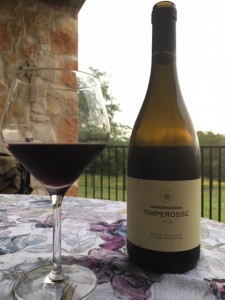During the travel restrictions resulting from the Covid pandemic, it was difficult to develop articles based on tasting Italian wines. However, Wellcom in Italy and several of their clients helped me meet this challenge by sending their wines to me.
Sicily’s Cantine Settesoli’s Mandrarossa Label has been most generous, and with their US importer, Palm Bay International, they provided a large number of their wines for tasting. Their last shipment provided the material for this lengthy article.
I will begin with the white wines and will forgo my usual inclusion of the food that accompanied the individual tasting. The first white wine was a 2018 Zibibbo Secco IGT, a 100% Zibibbo grape, 12.5% alcohol offering. The Zibibbo grape also known as Moscato di Alessandria, probably was brought to Sicily during the Arab occupation many centuries ago. The Zibibbo had cryomaceration and the must was fermented for 15-20 days in stainless steel tanks. Aging was for four months in stainless steel tanks. The resulting wine was a very pale straw color with a light fruit nose. It finished medium and smooth with a slight acidic taste. I rated the Zibibbo an 88.
The next white was a 2018 Grillo DOC, a 12% alcohol, 100% Grillo grape offering. Grillo is thought to be a relatively recent addition in Sicily in the 1800s. It is a cross between Cataratto and Moscato di Alessandria (Zibibbo). The Grillo was treated in the same manner as the Zibibbo above. The resultant wine was very pale straw in color with a very light nose. It finished medium long and smooth and I rated this excellent example of Grillo a 90. It is a very drinkable wine as an aperitif or with seafood.
The third white we tasted was a 2018 Chardonnay Laguna Secca DOC, a 13% alcohol, 100% Chardonnay grape wine. Again, the Chardonnay Laguna Secca was treated in the same manner as the previous two wines. The product of this was very pale straw color with a light fruit nose. It finished medium long and smooth and I rated this very nice chardonnay a 91.
Our last white which we had tasted in the past was a 2017 Bertolino Soprano DOC, a 12.5% alcohol, 100% Grillo grape offering. The only difference for the Bertolina Soprano and the three previous whites was that the aging was for one month in stainless steel and concrete tanks followed by 11 months in large oak barrels. This wine was pale yellow in color with a fruit nose. It finished medium and I rated it an 89/90. I should add that I do not normally prefer white wines that are aged in oak. This is purely personal.
Let us move to the reds. We begin these with a 2017 Cartagho DOC , a 14% alcohol, 100% Nero d’Avola wine. The Cartagho was fermented for 10 days in stainless steel tanks at 72-75°F with aging for 12 months in French oak barriques. A further four months aging in the bottle followed. The result was a wine with a dark ruby color and slight fruit nose. It finished medium long and smooth. I rated this good example of a Nero d”Avola a 90.
Our second red was a 2018 Frappato IGT, a 13% alcohol, 100% Frappato grape wine. The Frappato had a maceration of 6-8 days in stainless steel tanks at 71-77°F, and after removal of the lees was aged for 8 months in stainless steel tanks. The product of this process was a wine that was light ruby in color with a fruity nose. It finished light and medium. Before I give my rating, I must add that I am a great fan of the Frappato grape. My wife and I loved this wine and I rated it a 92/93. If you are looking for a light red wine that would go well with seafood, the Frappato is your answer.
Next we tried a 2016 Terre del Sommaco DOC, the clear label winner which was a 14% alcohol, 100% Nero d”Avola wine. The Terre del Sommaco had a maceration of 6-8 days at 71-77°F followed by aging of 6-8 months in stainless steel and concrete tanks. After this it spent 19 months aging in large oak barrels plus another 8 months in the bottle. The result was a wine with a ruby color and a fruit nose. It finished medium long and smooth. I liked this excellent Nero d’Avola and rated it a 92/93.
Moving away from pure Nero d’Avolas we tried a 2018 Bonera Doc, a blend of 50% Nero d’Avola and 50% Cabernet Franc. The Bonera was a 13.5% alcohol wine that, after adding a special yeast, was fermented at 77°F in stainless steel tanks, then aged for 3-6 months in French oak barriques followed by another 4 months in the bottle. The Bonera had a dark ruby color and a complex nose. It finished medium long and smooth and I rated it a 91. It will be good with pork dishes.

Mandrarossa’s Timperossa wine. PHOTO: Terry Duarte.
Our last red was a 2018 Cabernet Sauvignon Serra Brada, a 13.5% alcohol, 100% Cabernet Sauvignon grape wine. The Cabernet Sauvignon had a maceration and fermentation of 6-8 days at 71-77°F. It was aged for 8 months at 50°F in stainless steel tanks and then stood for 3 months in the bottle. This wine had a ruby color with a very light leather nose. It finished medium long and very smooth with intense minerality. I liked this elegant European style Cabernet Sauvignon and rated it a 91/92.
Thanks to the people at Mandrarossa and Palm Bay for providing these wines.




